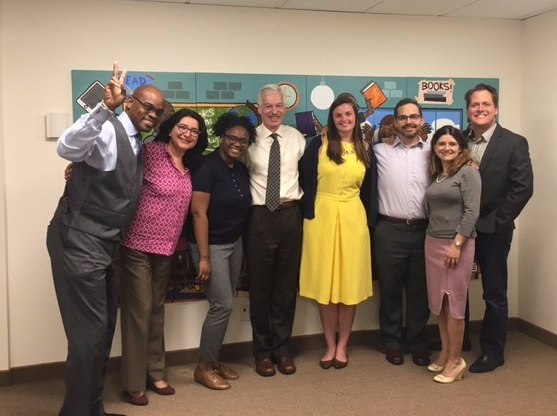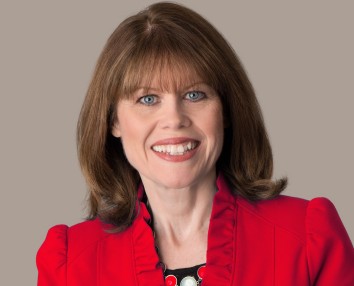We have found a new home! Kindly visit this link in our new website here: https://www.denver-frederick.com/2017/06/27/the-business-of-giving-visits-the-offices-of-first-book/
Better Than Most is a regular feature of The Business of Giving examining the best places to work among social good businesses and nonprofit organizations.
Denver: Today, we will be heading down to our nation’s capital and to the offices of First Book, a nonprofit social enterprise that provides new books, learning materials and other essentials to children in need. We will begin with their President and CEO, Kyle Zimmer, and then hear from the other members of the staff about the secret sauce that makes First Book a special place to work.

Kyle Zimmer and Denver Frederick
Kyle: Culture of the organization is paramount because it will affect everything you do… and a lot of things that you can’t do. It’s been important to us from the day we opened our doors. I believe strongly in team leadership. I don’t believe that having a single lone wolf at the helm of an organization is a healthy strategy; I don’t think it is a sustainable strategy. And so for starters, we have a team of four people at the top of the organization who are really co-equals in running it. In addition, we really work hard to elevate entrepreneurial thinking and to attract entrepreneurs into the organization
Jennifer: I’ve been given opportunities to be challenged and to really manage up. So to do things that I’ve never had the opportunity to do before and really show and prove myself as a professional, and I think that’s really special and not every organization gives their employees an opportunity to do that.
Michael: The thing about First Book that always has me coming back for more is it’s kind of like coming to a playground of challenges every day and hanging out there with your friends. And so, under the big umbrella of getting more books out into the world, there are all of these smaller umbrella challenges, and smaller problems and issues and tasks to go through, whether it’s how do we get books to rural areas more effectively, whether it’s how do we let our network talk to each other so that they’re using our books more effectively or how do we make it easier for everybody in the US or people abroad to get books. There’s always this sense of there’s another great challenge, there’s another thing to work on, and you’ve got a lot of cool, interesting, smart people to roll up your sleeves with and try to figure them out.

Dan: And after we hit a great milestone, we’ll pop some champagne, we’ll eat and we’ll laugh and have a good time, and then we clean up and we get right back to climbing that hill. So I think it’s critically important that you’re able to come to a job that challenges you, that has a great mission, but also allows you to have a good time.
Paula: I’ve been at First Book for almost 10 years already, and one of my favorite things about the organization is how fearless we are and how we don’t settle for things that we have already achieved. We keep looking for more. We set challenges and goals, but once we have achieved those, we look for more.
Anna: But we really are trying to meet the goals of that corporate partner and the goals of First Book. So as we grow and change and the partner grows and change, we want to make sure that we’re fitting in and making the best out of all of the goals and the needs of both parties.

Jennifer: So in every single performance evaluation that I’ve had at First Book, my manager has given me the opportunity to talk about my performance and how I feel about it, but also talk about their performance and how I feel about their management style, what’s working for me and what’s not working for me, and what they can do better to make sure that I feel supported, to make sure that I feel successful, and to make sure that I’m challenged and see a future for me here at First Book. So that, I think, is really important to me. It makes me feel valued in the same way that each one of our members feel valued.
Dan: I ask them questions like “What is your professional Shangri-La when it comes to work environment?” “Would you prefer to work in an office alone or with other folk?” “Can you make a joke or take a joke?” These are things that are important to the culture here, so these are questions that I’m constantly asking candidates when their potentially looking for jobs, including “Why First Book? Why would you want a job here?”
Roxana: I think that’s the kind of environment that we come to everyday that makes it really easy to come to work, and I think we get to celebrate it with traditions that we sort of look forward to. I’m going to say one that I enjoy a lot just because I think it defines, for me, First Book – it’s our Halloween celebration. Because we go all out, people get very creative and very competitive about “What are we going to do for Halloween? Because we have to come up top. We’re going to have to really rock it this year.” And people are so committed to the work that they find ways to put thematic/themes into their costumes and just really have a lot of fun, so that makes coming to work really, really special.

Paula: We not only do that through our program such as the Stories For All program in which we try to bring to schools titles that speak to minorities and different groups of people, but we also do a lot of that within the organization. Wherever you look in the offices here in Washington, you’re going to see a diverse group of people from different backgrounds, and First Book does a great job of making them feel inclusive, included in every single thing that we do as an organization.
Chandler: I was going to talk about work life balance, which maybe I don’t achieve so well all the time, but, in a way , I kind of love that because work life balance sort of implies that the thing that you do during the day is somehow other than who you are at core. And I think for me and I think for a lot of us here, I get a lot of my identity out of this organization and who we are in terms of the work that we’re doing together.

Chandler: I think one thing that I’m really proud of with regard to our culture is really trying to encourage a culture of innovation. I think that a lot of groups do that and they tend to focus on good innovative ideas that work, which is great, but we also really try to celebrate good innovative ideas that fail.
The way we do that is something called the First Book Brick Award and our Brick Wall Award, sort of illustrating the fact that we know that sometimes you have a great idea and for whatever reason, you hit a brick wall and it doesn’t work. But the thing that we want to celebrate is the people that have ideas that really are passionate about them. They think about ways to lay them out. They don’t let a fear of failure stop them from sort of pushing the boundaries of creativity, pushing the limits of what we usually do, challenging conventions that we might always have held in the past. So by purposefully calling out once a year the best ideas that failed, we really try to encourage everyone to not let the fear of failure prevent them from trying that thing that might really propel us forward.
Denver: I want to thank Joyce Johansson who helped organize my visit and to all those who participated, Anna Anderson, Chandler Arnold, Jennifer Cobb, Michael Jones, Dan Stokes, Roxana Barillas and Paula Neira. Podcast, transcript and pictures of the participants in the office of the First Book are all up on denverfrederick.wordpress.com

The Business of Giving can be heard every Sunday evening between 6:00 p.m. and 7:00 p.m. Eastern on AM 970 The Answer in New York and on iHeartRadio. You can follow us @bizofgive on Twitter, @bizofgive on Instagram and at http://www.facebook.com/BusinessOfGiving



